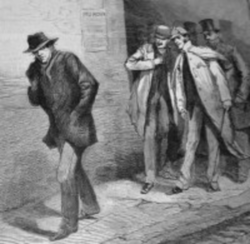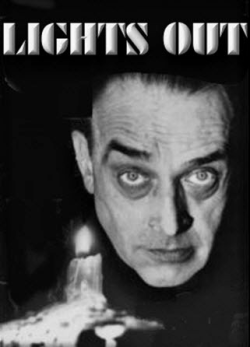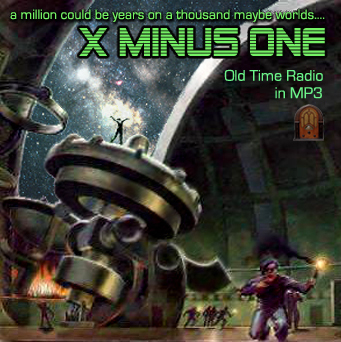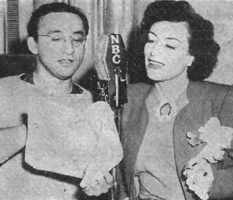Crime Crime Classics:
The Boorn Brothers & The Hangman – A study in Nip and Tuck(01/27/54).
***
Lights Out:
Knock at the Door (12/15/42 ).
***
X Minus One:
Early Model (07/11/57).
***
Arch Obolers Plays:
The Ways of Men; Past,
Present and Future (04/15/39).
Right Click here to download
![]()
Is Crime Crime Classics – “The Boorn Brothers & The Hangman – A study in Nip and Tuck” which originally aired on January 27, 1954.
Crime Classics is sometimes called a, “Docudrama“( I know I’ve been guilty of that myself). But I have come to think that this is a bit too grand a claim. To start off with you have, in the person of the host, a completely fictional “expert”. There is not now nor was there ever a ,”Thomas Hyland” (played by Lou Merrill ). Also, I have found while researching backgrounds of individual programs the historical content to be a bit dodgy; with the show willingly repeating legends and interesting anecdotes as well-established facts. Nonetheless, I will rise in defense of the program (of which I am very fond), to remind you that the entertainment industry of the 1950s was not different from that of our own time when inconvenient facts are simply not allowed to interfere with a good story.
I do not think that producer/writer Elliott Lewis intended for these shows to be taken as historical documents. He was, after-all, a producer of popular entertainment using the vehicle of tongue-in-cheek re-creations of some of history’s more interesting crimes.
The fact is Crime Classics freely mixes fact and fiction and tosses in apocryphal and anecdotal details as garnishments. I don’t think the producers were attempting to create an historically accurate account but entertainment. In this they succeeded, for entertaining they were and are.
And so we are off…

“The Boorn Brothers and the Hangman–A study in Nip and Tuck” which takes place in early 19th-century New England presents itself as the true tale of a wife who, with her two brothers, plot to dispose of her rather lack-wit husband.
I Have to say that the series, in this case, exhibits a somewhat loose connection to the facts. The story is based on something that actually did happen and it happened to the people named in the location given. But, in several of the details should not be trusted.
If you’re interested in knowing more about this case I ran into a pretty good, not overly verbose discussion:
![]()
Segment two is from Lights Out for December 15th of 1942, “Knock at the Door”.
Light’s Out, is one of the most famous radio shows of all time. Pretty much everyone has heard of it. Although , I admit sometimes this awareness is limited to Bill Cosby’s Chicken Heart routine.
Created by Willis Cooper in 1934, and passed on to Arch Oboler in 1936. Lights Out as a radio series would finally succumb to its own mortality in 1947. The franchise did not end with the demise of the radio show. Lights Out would turn up as a TV series from 1949 to 1952. There have been occasional attempts to revive the series that never had any notable success.

“Knock at the Door” is a fairly decent ghost story that starts with a woman who drowns her mother-in-law in a basement well.That’s pretty bad but soon she hatches a plot to dispose of her not too bright husband in the same way.
Ah, but mothers love takes a hand from beyond the grave, or maybe it’s just from the grave. Whatever… mama loves her boy.
It’s a fun little ghost yarn that has everything you’d want from old-time radio horror. Oh, and on what I consider to be on the positive side. The three main characters are completely unlikeable.
I enjoyed this episode where once again Oboler displays his ability, his facility, with dialogue. …
![]()
X Minus One does an adaptation of one of Robert Sheckley’s short stories, “ Early Model” (07/11/57).
X Minus One is considered the finest science fiction drama ever produced for radio. It was not the first. That honor belongs to 2000+. It wasn’t the second, That would be Dimension X. In fact the first 15 episodes of it’s 1955 to 1958 run on NBC were new versions of Dimension X episodes. The remainder were all most entirely adaptations of recently published science fiction stories (Mostly from Galaxy Science Fiction Magazine) usually written by the leading writers of the time, including Philip K. Dick, Fritz Leiber, J.T. McIntosh, Robert A. Heinlein, Frederik Pohl and Theodore Sturgeon.
For all of us who were weaned on The Outer Limits and The Twilight Zone and for the Trekkies (er,Trekkers) among us, you should know that X Minus One is the forefather of the science fiction you grew up on. You will find that it still is some of the best Science Fiction ever aired.

This episode of X minus one is the adaptation of a Robert Sheckley story, “Early Model”, which first appeared in “Galaxy Science Fiction” for August of 1956.
It’s the story of a first contact specialist saddled with this bulky device called a, “Proteck” for its test run.
Well wouldn’t you know it! It turns out that the, “Proteck” isn’t quite up to the job. Well, afterall it’s just a “Early Model”.
Robert Sheckley (July 16, 1928 – December 9, 2005) was a Hugo and Nebula nominated American author. First published in the science fiction magazines of the 1950s, his numerous quick-witted stories and novels were famously unpredictable, absurdist and broadly comical.
A few quotes:
- “Robert Sheckley: the best short-story writer the field has produced.” — Alan Dean Foster.
- “I had no idea the competition was so terrifyingly good.” — Douglas Adams.
- “Sheckley at his best is Voltaire and Soda.” — Brian W. Aldiss.
- “Probably the best short-story writer during the 50s to the mid-1960s working in any field.” — Neil Gaiman.
- “Always he crackles with ideas.” — Kingsley Amis.
- “[Robert Sheckley is] witty and ingenious… a draught of pure Voltaire and tonic.” — J. G. Ballard.
- “If the Marx Brothers had been literary rather than thespic fantasists … they would have been Robert Sheckley.” — Harlan Ellison.
- If this has whetted your appetite, whether or not you are familiar with Robert Sheckley’s work there is this nice webpage that I ran across recently, “Free Science Fiction online”. There is a lot of great stuff here.
-
May I suggest that you peruse this resource beginning with these stories from Robert Sheckley.
![]()
Here in segment and we have another dose of Arch Oboler this time as, “Arch Obolers Plays” presets, “The Ways of Men; Past, Present and Future” from April 13, 1939.
In 1939, with his own money, Oboler recorded an audition record of his play The Ugliest Man In the World, from which he hoped to launch a new radio series of idea plays. He brought the recording to his network, NBC. At the time, NBC was looking to launch an experimental radio series to rival CBS‘s Columbia Workshop. NBC was also looking for a radio writer and director to rival CBS’s Norman Corwin. NBC gave Oboler his own series, without a sponsor and with complete creative control. It was NBC that named the series Arch Oboler’s Plays. It was an almost unheard of honor. The time slot was less auspicious, the series occupied the Sunday 7-7:30 period opposite Jack Benny. An impressive roster of actors worked for scale to appear in Oboler’s plays, actors such as Bette Davis, Ronald Colman, Edmond O’Brien, Elsa Lanchester,James Cagney. Perhaps the most memorable broadcast was Oboler’s adaptation of Dalton Trumbo‘s Johny Got His Gun, starring James Cagney. The harrowing story of John Bonham, a World War I casualty with no limbs, eyes, ears, or mouth, was particularly suited to radio. Oboler created striking sound effects for the play, including the eerie vibration of bed springs, which Joe Bonham learns to recognize as the movement of people entering and exiting his hospital room.
Oboler’s series was so successful that it attracted the sponsorship of Proctor and Gamble. The new series was titled Everyman’s Theatre. Everyman’s Theatre was essentially Arch Oboler’s Plays with commercial sponsorship. The series ran from 1940 to early 1941. Oboler lost patience with the series because of the middle commercial interruption that came during his plays. After the series ended, it took almost a year before Oboler’s services were called on again.
Arch Oboler’s Plays was Oboler’s breakout dramatic showcase over Radio. Everyman’s Theater further established Oboler’s versatility and range, while underscoring Oboler’s growing appeal to a far wider audience than he’d already established with Lights Out!. Though eight years his senior, the diminutive Oboler, while never as widely popular as Orson Welles, invites comparison to the other great young playwright-actor-director. Their skills were clearly each other’s equal, their versatility had already been amply demonstrated by 1940, and their genius was indisputable. It’s also clear that both Wyllis Cooper and Norman Corwin served to influence and inform Oboler’s growing, wider appeal.
The Arch Oboler’s Plays franchise aired in one form or another over a period of almost thirty-three years, counting the original canon of fifty-three new radioplays, the subsequent special canon of twenty-six radioplays for the Mutual Broadcasting System (1945), then a 1964 revival, and finally a 1971 revival. The original canon of scripts encompassed some ninety-plus original stories. And, as dyed in the wool Lights Out! fans will surely point out, a good number of Lights Out! stories were reprised among the Arch Oboler’s Plays canon over the years as well.

This Episode is really a compendium of three stories with a common theme running through them .
Mar 28, 2012 @ 01:29:12
dear gary your show is great, its like slipping into an alternate reality where everything is ok, the icing on the cake is your commentary and remarks, they add warmth and value to every episode, thank you so much for your enchanting and refreshing oasis
Mar 28, 2012 @ 14:36:24
Thanks so much;
I do want this to be a warm and safe place, but one where occasionally the unexpected crops up.
gary